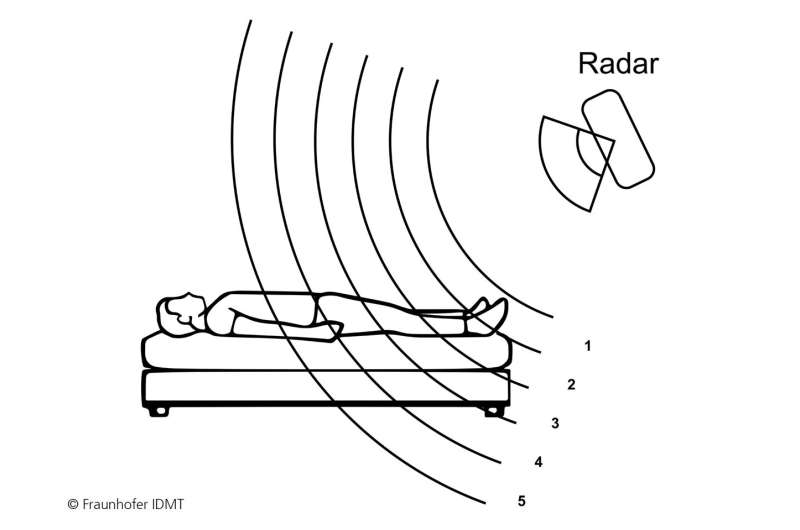This article has been reviewed according to Science X's editorial process and policies. Editors have highlighted the following attributes while ensuring the content's credibility:
fact-checked
proofread
Novel recording and analysis methods for simultaneous monitoring of vital signs and motion data via radar

Researchers at the Fraunhofer Institute for Digital Media Technology IDMT in Oldenburg have developed a new method for collecting and analyzing vital signs from the human body by using radar. The key feature is that the radar can be positioned sideways to collect particularly robust, non-contact vital data such as respiration and heartbeat from various areas of the body. In combination with intelligent analysis methods, this opens new application possibilities ranging from medical to automotive applications.
Respiration pauses during sleep, critical vital parameters of an infant or the necessary monitoring of respiration and heart rate in the intensive care unit and in nursing—there are many good reasons for recording vital data. Contact-based sensors are often used for this purpose, but they require time and effort to disinfect, attach or adjust. They also exert constant pressure on the body, which can be uncomfortable and promote sensor wear.
Radar measures vital and movement parameters of the human body without contact and is therefore particularly suitable for monitoring over longer periods of time. Its use can subsequently reduce waste, additional work and costs due to consumables and contact-based sensors. The researchers at Fraunhofer IDMT have set themselves the goal of strengthening the use of radar in health monitoring through intelligent recording and analysis procedures.
Vital data from body movements
A radar measuring device registers movements of the person from a distance. These can be large movements of the limbs, but also smaller movements along the surface of the skin, such as the pulse or the respiration movement along the torso. Fraunhofer IDMT works with a radar system that divides the space in front of the sensor into equal-sized sections. Each section is simultaneously examined for movements.
In the case of pulse and respiratory movements, the skin in the respective section approaches the radar sensor and moves away again. Researchers at Fraunhofer IDMT are working on simultaneously detecting, distinguishing and analyzing the many different movements of the body. By this, much information about vital parameters and the state of health of a person can be gained, even without contact sensors.
The angle makes the difference
In common use, the radar sensor is often positioned in front of the patient's abdomen or behind the patient's back. As a result, the body in front of the sensor only extends over a few sections, in which many movements, such as pulse, the respiratory movement of the torso and movements of the limbs, overlap.
The researchers at Fraunhofer IDMT rely on lateral positioning of the radar measuring device, e.g., at the foot of the bed, which divides the human body into significantly more independent sections from the radar's point of view.
"Along the entire body, a wide variety of vital parameters can be observed at respective advantageous body regions. For example, we can clearly see the respiratory movement on the torso and the pulse on the legs at the same time—without any disturbing overlapping of the signals. By dividing the body into measurement sections during the measurement, the time-consuming separation of respiration and pulse after the measurement in the subsequent data analysis is no longer necessary," explains Lars Hornig, who developed the new method at Fraunhofer IDMT.
In the complete body model, which is divided into sections, even more information can be uncovered for evaluation. The distinction between abdominal and thoracic respiration is interesting, for example, for the detection of chronic obstructive pulmonary disease (COPD) or obstructive sleep apnea. In addition, insufficiently informative vital data from one body section can be supplemented by information from another body section.
Outlook: Vital data monitoring in vehicles, at the hazard workplace or at home
In principle, the monitoring of vital data with the new measurement and analysis methods is not only conceivable in the medical field. The Fraunhofer IDMT team is already testing the use of radar in vehicles for people in a seated position in order to monitor the vital parameters of the driver, e.g., for professional drivers or, in perspective, in autonomous vehicles. In this case, positioning the radar in the vehicle ceiling, for example, is conceivable.
In addition, the radar could be used in hazardous workplaces to protect employees by monitoring vital signs in addition to existing protective measures. At home, the radar can provide data for sleep monitoring to avoid the long waiting time for a sleep lab measurement and at the same time collect particularly meaningful data from everyday life. Likewise, the use in a smart assistant for stationary or home life is envisaged, which in addition to audio and video sensor technology also uses the radar and thus extends the range of applications to the vital data described above.



















